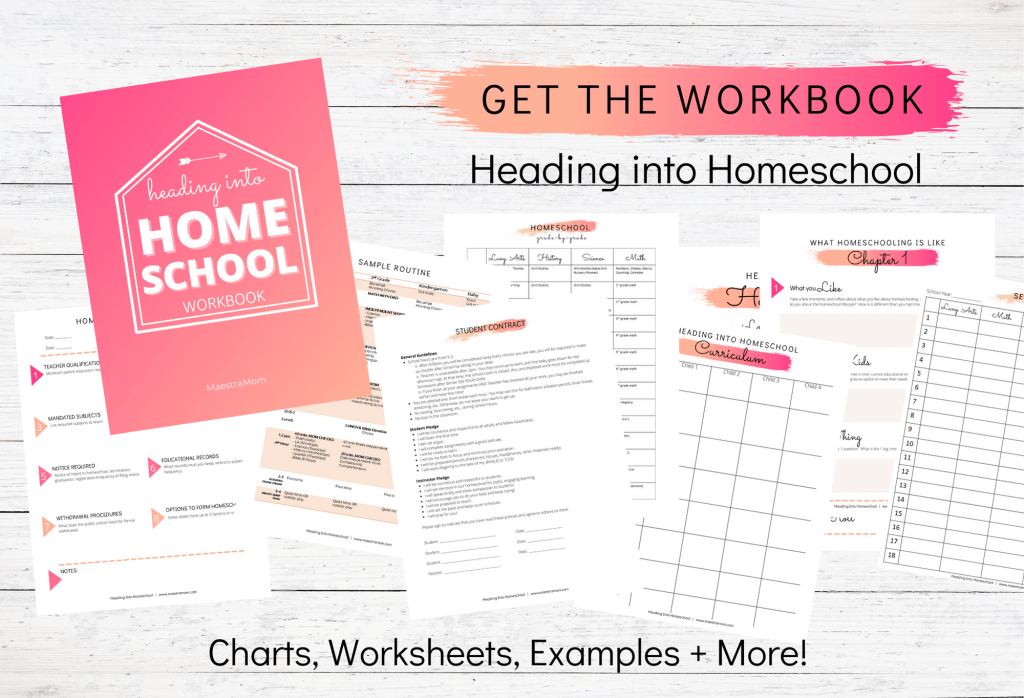Help! How do I know what subjects to teach in homeschool?
So you’ve decided to homeschool and a thousand questions are going through your mind. But one of the first that usually requires an answer, is what subjects to teach in homeschool? And it’s a biggie! Once you figure this piece out, you’ll feel so much better and be able to move forward!
Before You Start
To begin with, you need to check to see if your state (in the United States) has required subjects for homeschools. Some do! If so, jot those down.
Thirty-three of the states specifically outline a minimum of subjects that must be taught in the homeschool, although, surprisingly, the lists of subjects varies. Texas requires math, reading, spelling, grammar, and good citizenship. California, on the other hand, requires language arts, math, science, social studies, health, and driver’s training. Some states, such as Alabama, require that parents include a course of physical education. A few states dictate that instruction in the homeschool must be in English. Other states leave what subjects to teach in homeschool entirely up to the families!
Just make sure to check out your state’s requirements. A quick google search should give you an answer!

Then, before we dive in, go grab your free download of the Homeschool Planning Templates so you can fill them out as we go along. These amazing worksheets are designed specifically for you to help make homeschool planning as easy as possible! They go hand-in-hand with the chapters of my book, Heading into Homeschool, and are completely free when you purchase the book on Amazon.
What Subjects to Teach in Homeschool
Now you get to start the fun! Here’s how it works in a nutshell: you will need to teach the CORE subjects plus a few ELECTIVES. Easy-peasy!
CORE SUBJECTS – These are your basics.
ELECTIVES – These are the enrichment classes and extras. We’ll talk more about what is considered elective courses in a moment.
STEP 1: Choose Homeschool Core Subjects
Begin by writing a list of basic core subjects you plan to teach for each child. More than likely, these will include the core subjects that all students typically study during the elementary and junior high years.
- Math
- Language Arts (includes reading, writing, spelling, grammar, and handwriting)
- Science
- History/ Social Studies (includes geography and civics)
In pre-k, kindergarten, and 1st grade, your main goal is to teach reading and math. This means that you may not teach the remaining subjects every day. Many homeschool families teach science and history on alternate days only during the elementary years in order to focus more on literacy. Some homeschool families simply incorporate science and history topics into their reading and writing and do not teach them separately at all until upper elementary. More than anything, you want your child to become a solid reader by the end of 1st grade! So focus on the language arts!
On the other end of the spectrum, if you have a high school student, you will want to look up the specific high school graduation requirements in your state. Most states have specific courses which are required for graduation as well as a predetermined number of elective courses. If you are homeschooling a junior high student, go ahead and look up the high school requirements so you can be getting your student ready with the prerequisite courses they’ll need to succeed in high school.

STEP 2: Choose Elective Courses
Next, after making sure you have listed all the basics for your child, consider what additional homeschool subjects you may want to teach. There are so many from which to choose! These are the enrichment and extra classes that are often lots of fun! Electives, which are additional courses beyond the basics, generally fall into one of these categories for all grade levels and may include but are not limited to the following:
Languages
- Spanish
- Sign Language
- Latin
- Chinese, etc.
Fine Arts
- art
- music
- theater
- dance, etc.
Physical Education
- fitness
- sports
- nutrition
- health, etc.
Life-Skills
- logic
- cooking
- sewing
- woodworking
- gardening
- auto repair
- finance, etc.
Technology
- typing
- robotics
- coding
- graphic design
- photography, etc.
Character & Religious Education
- Bible study
- virtues
- character education programs
- etiquette, etc.
The choices are limitless! Just be careful! Kids don’t need all types of electives each year. They quickly get overloaded and bogged down if you add too much to their subject load.
Kids may only do an elective once or twice a week instead of daily as well, such as participating in a sport. And these fun extras may or may not be included in the actual school day. Another option is to do an elective for only a semester or 6 weeks and then try another. One of the hallmarks of homeschooling is flexibility!
How many electives do you need?
Keep it simple. In our home, each child has daily Bible study every year because instilling faith in our kids is of the utmost importance. Beyond that, all the kids do music lessons and then we aim for only one or two more electives per year. You can rotate through different types of electives through the years to help your child become well-rounded and exposed to new ideas.
The homeschool lifestyle offers abundant opportunity for parents to instill their values, teach faith, and encourage love of family. There is ample time in the homeschool day to teach character and virtue education based on God’s morality and the Christian worldview.
Homeschooled children often learn to care for younger siblings and have more time to spend on chores and other life skills such as cooking, cleaning, home maintenance, car maintenance, etc., making them an integral part of family life. So, some of the elective topics may already be covered naturally in your regular family routines.
Choosing Homeschool Subjects to Teach in Homeschool
So, while the possibilities are endless, remember to keep it simple and not overload. A sample schedule for a student in K-8, then, might include:
- Language Arts
- Math
- Science
- History
- Bible
- Elective 1
- Elective 2
That’s it! Now you’ve chosen what subjects to teach in homeschool and you’re ready to move on to the next step in the journey – choosing curriculum!
Some FREE stuff to help you get started:
>>> Homeschool Planning Templates
>>> How to do homeschool planning

Heading into Homeschool
Finally – the best resource of all isn’t free, but pretty close! It’s cheaper than a cup of coffee and will be immensely valuable to you on this homeschool journey. Grab a copy of my Heading into Homeschool ebook (or print version) on Amazon.
It will walk you step-by-step through every single step of the homeschooling preparation journey so you know exactly what you need to do and how to make it happen. You’ll be so glad you snagged a copy! Plus, it comes with 28 pages of homeschool planning templates, sample routines, and more that will make your homeschool planning a cinch.


